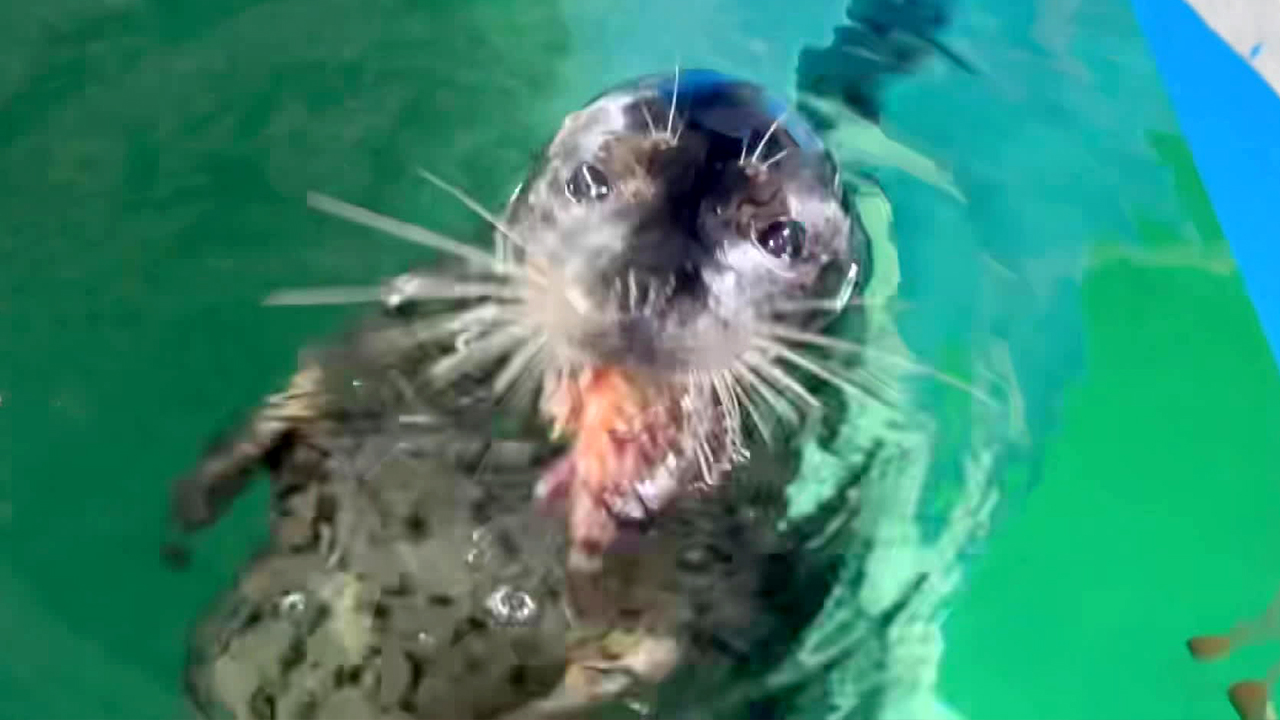Spotted seals rescued in the East Sea released to Garoim Bay in the West Sea
입력 2024.10.17 (00:39)
읽어주기 기능은 크롬기반의
브라우저에서만 사용하실 수 있습니다.
[Anchor]
A pair of baby spotted seals, a natural monument, rescued from the East Coast of Gangwon Province, have grown well under the care of their keepers and have returned to nature.
After completing their adaptation training, they were released into their habitat in the Yellow Sea, and our reporter Park Byeong-jun visited the site.
[Report]
The seal, appearing tense, looks around, and as the cage door opens, it kicks off the sand and jumps into the sea.
The other seal, hesitating, begins to swim along the waterway between the sandbars.
They explore the surroundings together, linger near the people, and then disappear into the ocean.
They are spotted seals, which are natural monuments and classified as endangered wildlife level 2.
They were rescued from the coast of Gangneung and Yangyang in Gangwon Province last year and this spring, respectively.
[Hwang In-seo/Director of Marine Ecology, Korea Marine Environment Management Corporation: "Considering that they are not entering the water even though people are approaching or observing for a long time, it seems that they are quite exhausted and in a state of depleted energy."]
The names of the pair of seals are 'Bom' and 'Yangyang,' named after the time and place of their rescue.
They grew to half the size of adults under the protection of their keepers and completed natural adaptation training, including live fish hunting, before being released into the Yellow Sea's Garolim Bay, where adult groups are present.
It is estimated that about ten spotted seals are living in groups in the Garolim Bay area.
This is considering their characteristic of breeding in the Liaodong Bay of China during winter and returning to the Yellow Sea in spring.
[An Yong-rak/Director of Marine Biodiversity, National Marine Biodiversity Institute: "When the individuals found in the East Sea are released into Garolim Bay in the West Sea, we can gather new data on whether they move to the habitat in the West Sea or return to the East Sea."]
The research team plans to recapture the seals with satellite tracking devices if they do not adapt to nature.
This is KBS News, Park Byeong-jun.
A pair of baby spotted seals, a natural monument, rescued from the East Coast of Gangwon Province, have grown well under the care of their keepers and have returned to nature.
After completing their adaptation training, they were released into their habitat in the Yellow Sea, and our reporter Park Byeong-jun visited the site.
[Report]
The seal, appearing tense, looks around, and as the cage door opens, it kicks off the sand and jumps into the sea.
The other seal, hesitating, begins to swim along the waterway between the sandbars.
They explore the surroundings together, linger near the people, and then disappear into the ocean.
They are spotted seals, which are natural monuments and classified as endangered wildlife level 2.
They were rescued from the coast of Gangneung and Yangyang in Gangwon Province last year and this spring, respectively.
[Hwang In-seo/Director of Marine Ecology, Korea Marine Environment Management Corporation: "Considering that they are not entering the water even though people are approaching or observing for a long time, it seems that they are quite exhausted and in a state of depleted energy."]
The names of the pair of seals are 'Bom' and 'Yangyang,' named after the time and place of their rescue.
They grew to half the size of adults under the protection of their keepers and completed natural adaptation training, including live fish hunting, before being released into the Yellow Sea's Garolim Bay, where adult groups are present.
It is estimated that about ten spotted seals are living in groups in the Garolim Bay area.
This is considering their characteristic of breeding in the Liaodong Bay of China during winter and returning to the Yellow Sea in spring.
[An Yong-rak/Director of Marine Biodiversity, National Marine Biodiversity Institute: "When the individuals found in the East Sea are released into Garolim Bay in the West Sea, we can gather new data on whether they move to the habitat in the West Sea or return to the East Sea."]
The research team plans to recapture the seals with satellite tracking devices if they do not adapt to nature.
This is KBS News, Park Byeong-jun.
■ 제보하기
▷ 카카오톡 : 'KBS제보' 검색, 채널 추가
▷ 전화 : 02-781-1234, 4444
▷ 이메일 : kbs1234@kbs.co.kr
▷ 유튜브, 네이버, 카카오에서도 KBS뉴스를 구독해주세요!
- Spotted seals rescued in the East Sea released to Garoim Bay in the West Sea
-
- 입력 2024-10-17 00:39:09

[Anchor]
A pair of baby spotted seals, a natural monument, rescued from the East Coast of Gangwon Province, have grown well under the care of their keepers and have returned to nature.
After completing their adaptation training, they were released into their habitat in the Yellow Sea, and our reporter Park Byeong-jun visited the site.
[Report]
The seal, appearing tense, looks around, and as the cage door opens, it kicks off the sand and jumps into the sea.
The other seal, hesitating, begins to swim along the waterway between the sandbars.
They explore the surroundings together, linger near the people, and then disappear into the ocean.
They are spotted seals, which are natural monuments and classified as endangered wildlife level 2.
They were rescued from the coast of Gangneung and Yangyang in Gangwon Province last year and this spring, respectively.
[Hwang In-seo/Director of Marine Ecology, Korea Marine Environment Management Corporation: "Considering that they are not entering the water even though people are approaching or observing for a long time, it seems that they are quite exhausted and in a state of depleted energy."]
The names of the pair of seals are 'Bom' and 'Yangyang,' named after the time and place of their rescue.
They grew to half the size of adults under the protection of their keepers and completed natural adaptation training, including live fish hunting, before being released into the Yellow Sea's Garolim Bay, where adult groups are present.
It is estimated that about ten spotted seals are living in groups in the Garolim Bay area.
This is considering their characteristic of breeding in the Liaodong Bay of China during winter and returning to the Yellow Sea in spring.
[An Yong-rak/Director of Marine Biodiversity, National Marine Biodiversity Institute: "When the individuals found in the East Sea are released into Garolim Bay in the West Sea, we can gather new data on whether they move to the habitat in the West Sea or return to the East Sea."]
The research team plans to recapture the seals with satellite tracking devices if they do not adapt to nature.
This is KBS News, Park Byeong-jun.
A pair of baby spotted seals, a natural monument, rescued from the East Coast of Gangwon Province, have grown well under the care of their keepers and have returned to nature.
After completing their adaptation training, they were released into their habitat in the Yellow Sea, and our reporter Park Byeong-jun visited the site.
[Report]
The seal, appearing tense, looks around, and as the cage door opens, it kicks off the sand and jumps into the sea.
The other seal, hesitating, begins to swim along the waterway between the sandbars.
They explore the surroundings together, linger near the people, and then disappear into the ocean.
They are spotted seals, which are natural monuments and classified as endangered wildlife level 2.
They were rescued from the coast of Gangneung and Yangyang in Gangwon Province last year and this spring, respectively.
[Hwang In-seo/Director of Marine Ecology, Korea Marine Environment Management Corporation: "Considering that they are not entering the water even though people are approaching or observing for a long time, it seems that they are quite exhausted and in a state of depleted energy."]
The names of the pair of seals are 'Bom' and 'Yangyang,' named after the time and place of their rescue.
They grew to half the size of adults under the protection of their keepers and completed natural adaptation training, including live fish hunting, before being released into the Yellow Sea's Garolim Bay, where adult groups are present.
It is estimated that about ten spotted seals are living in groups in the Garolim Bay area.
This is considering their characteristic of breeding in the Liaodong Bay of China during winter and returning to the Yellow Sea in spring.
[An Yong-rak/Director of Marine Biodiversity, National Marine Biodiversity Institute: "When the individuals found in the East Sea are released into Garolim Bay in the West Sea, we can gather new data on whether they move to the habitat in the West Sea or return to the East Sea."]
The research team plans to recapture the seals with satellite tracking devices if they do not adapt to nature.
This is KBS News, Park Byeong-jun.
-
-

박병준 기자 lol@kbs.co.kr
박병준 기자의 기사 모음
-
이 기사가 좋으셨다면
-
좋아요
0
-
응원해요
0
-
후속 원해요
0















이 기사에 대한 의견을 남겨주세요.